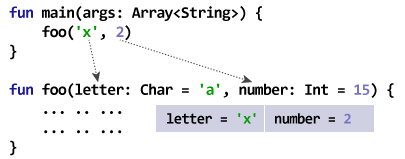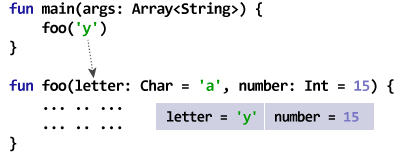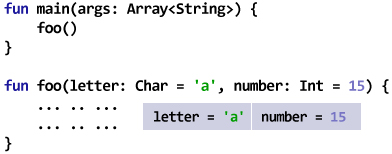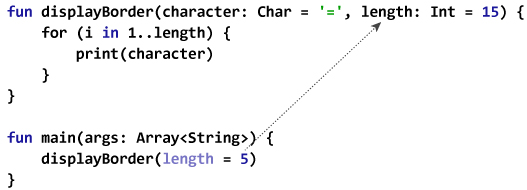原文: https://www.programiz.com/kotlin-programming/default-named-arguments
在本文中,您将在示例的帮助下了解默认参数和命名参数。
Kotlin 默认参数
在 Kotlin 中,您可以为函数定义中的参数提供默认值。
如果通过传递的参数调用该函数,则将这些参数用作参数。 但是,如果在不传递参数的情况下调用该函数,则会使用默认参数。
默认参数如何工作?
情况 I:所有参数均传递

函数foo()具有两个参数。 参数提供有默认值。 但是,通过在上述程序中传递两个参数来调用foo()。 因此,不使用默认参数。
在foo()函数内,letter和num的值分别为'x'和2。
情况 II:未传递所有参数

在此,仅一个(第一个)参数传递给foo()函数。 因此,第一个参数使用传递给函数的值。 但是,第二个参数num将采用默认值,因为在函数调用期间未传递第二个参数。
在foo()函数内,letter和num的值分别为'y'和15。
情况 III:不传递任何参数

在此,不传递任何参数就调用foo()函数。 因此,两个参数都使用其默认值。
在foo()函数内,letter和num的值分别为'a'和15。
示例:Kotlin 默认参数
fun displayBorder(character: Char = '=', length: Int = 15) {for (i in 1..length) {print(character)}}fun main(args: Array<String>) {println("Output when no argument is passed:")displayBorder()println("\n\n'*' is used as a first argument.")println("Output when first argument is passed:")displayBorder('*')println("\n\n'*' is used as a first argument.")println("5 is used as a second argument.")println("Output when both arguments are passed:")displayBorder('*', 5)}
运行该程序时,输出为:
Output when no argument is passed:==============='*' is used as a first argument.Output when first argument is passed:***************'*' is used as a first argument.5 is used as a second argument.Output when both arguments are passed:*****
Kotlin 命名参数
在讨论命名参数之前,让我们考虑对上面的代码进行一些修改:
fun displayBorder(character: Char = '=', length: Int = 15) {for (i in 1..length) {print(character)}}fun main(args: Array<String>) {displayBorder(5)}
在这里,我们试图将第二个参数传递给displayBorder()函数,并使用默认参数作为第一个参数。 但是,此代码将提供使用错误。 这是因为编译器认为我们正在尝试为字符(Char类型)提供 5(Int值)。
为了解决这种情况,可以使用命名参数。 方法如下:
示例:Kotlin 命名参数
fun displayBorder(character: Char = '=', length: Int = 15) {for (i in 1..length) {print(character)}}fun main(args: Array<String>) {displayBorder(length = 5)}
运行该程序时,输出为:
=====
在上面的程序中,我们使用命名参数(length = 5)指定函数定义中的length参数应采用此值(与参数的位置无关)。

第一个参数character使用程序中的默认值'='。

